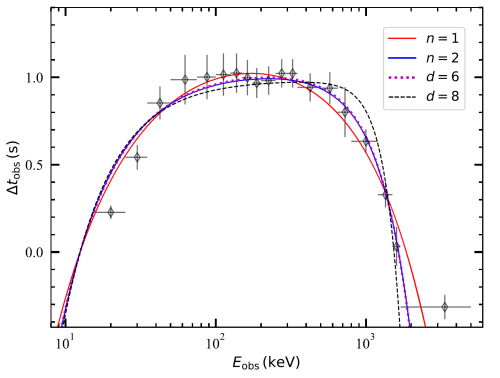Lorentz Invariance Violation Limits from the Spectral-lag Transition of GRB 190114C
The observed spectral lags of gamma-ray bursts (GRBs) have been widely used to study the LIV effects. However, these studies generally relied on the use of a single highest-energy photon and the assumption of the unknown intrinsic time lag in different energy bands. In 2017, WEI et al. proposed a new approach to test the LIV effects by directly fitting the spectral-lag behavior of GRB 160625B with a well-defined transition from positive lags to negative lags. This method provides both a reasonable formulation of the intrinsic energy-dependent time lags and robust limits on LIV.

Fig. 1 Observed spectral lags of GRB 190114C. The color curves correspond to the median values of estimated constraints for LIV effects parameterized by vacuum dispersion with Taylor expansion and standard model extension.
Very recently, the research team lead by Assoc. Prof. WEI Junjie from Purple Mountain Observatory of the Chinese Academy of Sciences showed decisive evidence that GRB 190114C is another burst with the spectral-lag transition (see Fig. 1). By performing a global fitting to the spectral-lag data of GRB 190114C, they derived limits on the QG energy scales and the coefficients of the standard model extension. Although their resulting constraints are somewhat weaker than existing bounds, they can be deemed as comparatively robust and have the promise to complement existing LIV constraints.
This work has been published in The Astrophysical Journal.